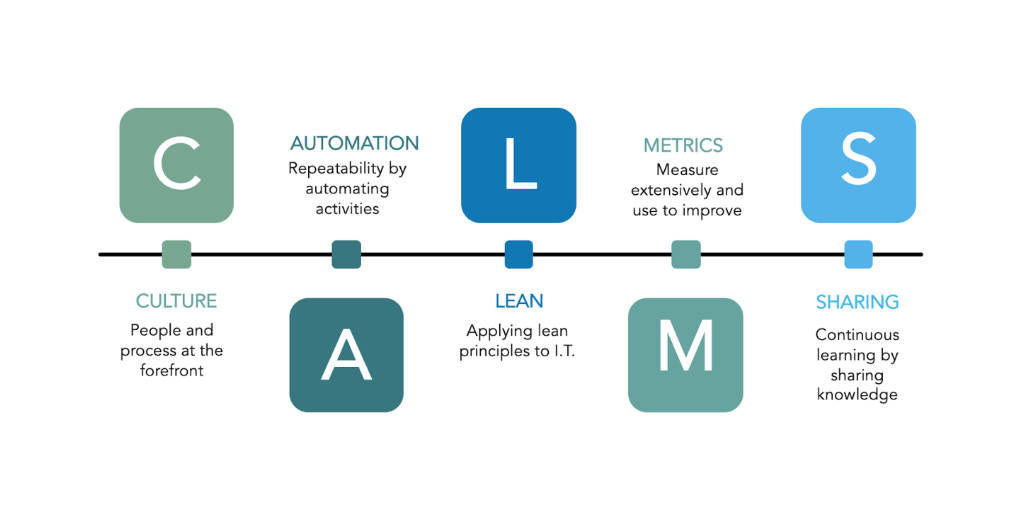Articles.
DevOps Essentials: Building a Culture of Collaboration and Efficiency
Sandile Mnukwa 01 Nov 2024 • 5 min read

What Is DevOps?
Throughout my experience in the DevOps space, I’ve come across numerous definitions of DevOps. I’ve even developed a few definitions of my own over time, and while each one varies slightly, they all converge around a similar core idea. However, there’s one definition that has always resonated with me, from The DevOps Handbook:
“Imagine a world where product owners, Development, QA, IT Operations and Infosec work together, not only to help each other, but also to ensure that the overall organization succeeds. By working towards a common goal, they enable the fast flow of planned work into production, while achieving world-class stability, reliability, availability and security.” (Kim et al., 2016).
It’s a bit of a mouthful, I know, but I love how it highlights the inclusion of other roles like Product Owners, QAs, and InfoSec, who are often overlooked in other definitions. This perspective emphasizes that DevOps isn’t just about Developers and IT Operations — it’s about creating a streamlined, collaborative approach across all roles to enhance software development and delivery.
At its core, DevOps is about breaking down silos. Traditionally, developers would write code and then “hand it off” to operations for deployment. This process often led to delays, misunderstandings, and — let’s be honest — a bit of frustration. DevOps aims to bridge that gap by promoting collaboration, using automation, and fostering continuous feedback to keep processes running smoothly.
What is Automation, Scaling, and Infrastructure?
Culture has a direct impact on an organisation’s recruitment efforts as potential employees are most likely to consider the culture of the organisation before joining. It will also determine whether or not the employees stay at the current place of work depending on how the culture is. Employee engagement is also higher in environments with a healthy culture. This includes the employee’s enthusiasm to go to work, their understanding of their role and how it contributes to the greater organisation. According to the Harvard Business Review, not only does higher employee engagement improve productivity it also lowers absenteeism and employee turnover. The quality of work produced also increases.
Every organisation aspires to attract the best people in the market and culture is an important aspect. Have you heard of the phrase “Culture will eat strategy for breakfast”? This essentially means you can have a great strategy but if your culture is not right it’s impossible for that strategy to be implemented successfully long term.
- Automation: One of the most essential aspects of DevOps is automation. Think of it as a way to eliminate repetitive tasks, saving time and reducing human error. Instead of manually deploying code every time there’s an update, automation tools handle it for you, making the process faster and more efficient.
- Scaling: Scaling refers to handling increased demand by adding more resources, like memory or CPU, when needed. This can be achieved by scaling horizontally, often called “scaling out,” which involves adding additional nodes or machines to your existing system. Alternatively, you can scale vertically, or “scale up,” where you enhance the performance of the system by upgrading components, such as increasing CPU power, if more processing power is required.
- Infrastructure: Infrastructure encompasses everything behind the scenes—servers, networks, databases—that powers an application. In DevOps, infrastructure is treated as code, known as Infrastructure as Code (IaC). By defining infrastructure through code, DevOps teams can set up, configure, and manage resources with consistency and speed.

DevOps Practices
Adopting DevOps requires a shift in mindset from both development and operations. For DevOps to truly succeed, both teams must work together, share a common language, align on goals, and have a mutual understanding of each other’s strengths and responsibilities.
The CALMS model was first introduced to me in a DevOps course from the DevOps Institute. Originally created by engineers Damon Edwards and John Willis, CALMS outlines the foundational principles that DevOps practices aim to instill:
- Culture: A culture that embraces agility, change, and continuous improvement, where each team is accountable for the end-to-end quality of software.
- Automation: Automating repetitive tasks to reduce manual effort and eliminate bottlenecks is a core objective in DevOps.
- Lean: Ensuring that software moves quickly and efficiently through each critical stage, minimizing delays.
- Measurement: Continuous measurement and feedback allow teams to track progress, make data-driven decisions, and adapt swiftly when necessary.
- Sharing: Knowledge sharing across teams and throughout the organization is essential for fostering collaboration and collective growth in DevOps.

What are the common technologies used in DevOps?
Within the DevOps world, there are a few go-to tools through my experience that have become essential in streamlining workflows and ensuring smooth deployments. Here’s a rundown of some of the most common ones:
- Version Control Systems (e.g., Git) – Manage and track code changes.
- Continuous Integration Tools (e.g., Jenkins, Travis CI) – Automate the building and testing of code.
- Containerization (e.g., Docker) – Package and deploy applications in a consistent environment.
- Configuration Management (e.g., Ansible, Puppet) – Automate infrastructure setup and management.
- Monitoring Tools (e.g., Grafana, New Relic) – Track system performance and availability.
- Cloud Platforms (e.g., AWS, Azure, GCP) – Provide infrastructure and services for deploying applications.
- ChatOps (e.g., Slack, Microsoft Teams) – Integrate DevOps workflows directly into chat platforms to monitor, control, and troubleshoot systems in real time.
These tools help make DevOps efficient, reliable, and scalable.
The Importance of Adopting a DevOps Culture
In today’s fast-paced digital world, speed and reliability are critical. DevOps enables companies to release software updates faster without sacrificing quality. Imagine your favorite app has a bug; with DevOps practices in place, the development team can quickly identify, fix, and deploy a patch, ensuring minimal disruption.
Another major advantage of DevOps is its ability to reduce risks. Automated testing and continuous monitoring mean that potential issues can be detected and fixed early, before they impact users. Ultimately, DevOps not only enhances the end-user experience but also creates a smoother, more enjoyable process for everyone involved in development and operations.
Wrapping Up
In this article, we discussed what is DevOps, what is automation, scaling, and infrastructure, discussed DevOps Practices, and the importance of adopting a DevOps culture.
DevOps is more than just a set of tools or practices—it’s a culture shift that encourages collaboration, efficiency, and faster delivery of high-quality software. Whether you’re looking to transition into a DevOps role or are just curious about the field, the opportunities are endless. With the right mix of technical skills, support and a collaborative mindset, you can make a significant impact on any software team.
This is the beginning of a series of write ups, focused on DevOps and everything about DevOps. Start small, experiment, constantly showing value as a team and embrace a continuous learning mindset! Good luck! 🚀

